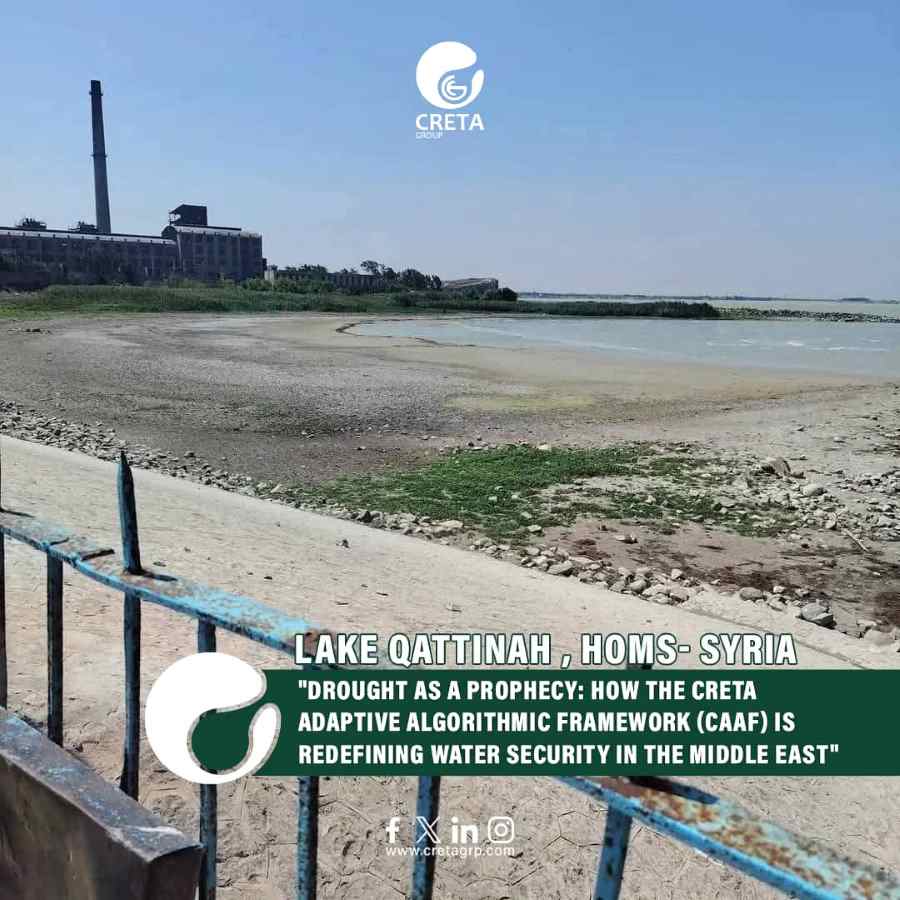Drought as a Prophecy: How the CRETA Adaptive Algorithmic Framework (CAAF) is Redefining Water Security in the Middle East
In the Middle East, water scarcity is no longer just an environmental problem. It has become a complex prophecy, foretelling a future of instability and conflict. The regional water crisis is not a result of a single factor but a dangerous confluence of rapid climatic shifts, escalating geopolitical tensions, and systemic governance failures.
At CRETA, we recognized that confronting this existential challenge required more than traditional solutions. It demanded a new model, one specifically designed to understand and disrupt the intricate link between environmental stress and social fragility. This is why we developed the CRETA Adaptive Algorithmic Framework (CAAF).
The CAAF: A New Approach to Water Security
The CAAF is a multi-layered decision-support system that breaks away from traditional, linear modeling. Unlike existing platforms, which often assume stable institutions and rational state behavior, the CAAF operates as a recursive methodology, allowing for continuous feedback loops between environmental indicators and governance triggers. It is conceived as a system that seamlessly connects disparate models from diverse fields such as hydrology, economics, and public policy, offering a more holistic picture than models that consider only isolated parts of the water cycle.
The CAAF’s methodology applies a three-layered approach:
- Hydro-climatic Data Assimilation: The framework integrates advanced climate projections from models like CMIP6 and ERA5 reanalysis datasets with real-time satellite-based groundwater depletion monitoring (GRACE). This provides a robust foundation for understanding the dynamics of water resources, a critical need as the region is projected to face a 20% reduction in rainfall and higher evaporation rates.
- Governance and Corruption-Adjusted Weighting: We understand that corruption and institutional weakness exacerbate the water crisis. Therefore, the CAAF embeds quantitative proxies from trusted sources like Transparency International’s Corruption Perceptions Index (CPI) and the World Bank’s Governance Indicators (WGI). By recalibrating hydrological projections with governance-based penalties, the model produces more realistic forecasts that account for the inefficiency and leakage inherent in fragile governance systems.
- Conflict Sensitivity Integration: The CAAF embraces the concept of water scarcity as a “threat multiplier”. It includes a :
Conflict Sensitivity Matrix (CSM) that quantifies the risk of water-driven instability by analyzing migration flows, displacement indices, and regional security alerts. This gives the CAAF a unique ability to provide an early warning not only for environmental crises but also for the social and political crises that can follow.
From Theory to Reality: A Prototype Simulation on Iraq
To demonstrate the CAAF’s capabilities, we conducted a prototype simulation on the Tigris–Euphrates basin, using data from Iraq for the period 2020–2024.
- Simulation Inputs: Data included downstream river inflows, GRACE groundwater depletion trends, annual rainfall anomalies, Iraq’s CPI corruption score (23/100 in 2023), and displacement figures (with over 1.2 million internally displaced persons linked partly to drought).
- The Findings: The Aquifer Stress Index (ASI) revealed a 34% over-extraction rate in southern Iraq’s aquifers. The Conflict Sensitivity Matrix (CSM) flagged a 0.72 risk probability (on a scale of 0–1) for escalating tensions between farmers and urban residents in water-stressed governorates.
- Policy Simulation: When we introduced a “digital twin” scenario of a 20% improvement in irrigation efficiency (via drip irrigation), the model projected a 15% reduction in agricultural water consumption, a 9% increase in wheat yield stability, and a 0.21 reduction in conflict risk probability.
This simulation demonstrates how the CAAF goes beyond predicting water quantities; it quantifies the potential for both hydrological resilience and conflict mitigation—a dual-layer analysis missing from conventional tools.
Bridging the Gap Between Technical and Political
Existing literature on Middle Eastern water scarcity has largely focused on climate impacts or hydro-political tensions in isolation. Traditional modeling tools like WEAP and SWAT, while robust, remain technocratic in their orientation, largely ignoring crucial factors such as corruption, governance fragility, and conflict sensitivity.
- WEAP models resource allocation but assumes rational state behavior and stable institutions.
- SWAT models agro-hydrological processes but is limited to watershed-scale environmental variables.
Neither tool explicitly integrates institutional weakness or quantifies political risk scenarios, both of which are defining features of the MENA water crisis. The CAAF addresses this gap by embedding governance and conflict dimensions directly into hydrological forecasting, making it uniquely suited for fragile states where the line between environmental stress and political collapse is thin.
Conclusion: A Roadmap for the Future
At CRETA, we believe a water-secure future is possible. The CAAF is more than an advanced forecasting tool; it is a roadmap for building resilience. It shows how technological and policy interventions can work together to prevent conflict and ensure water security for all. By providing an integrated, predictive framework, the CAAF empowers decision-makers to transform the prophecy of drought-driven instability into a blueprint for a more resilient and cooperative future.
For a more in-depth analysis, including detailed insights into the dynamics in Iraq, Lebanon, Syria, and Jordan, we invite you to request the full version of our report. Please contact us at info@cretagrp.com to gain access.

